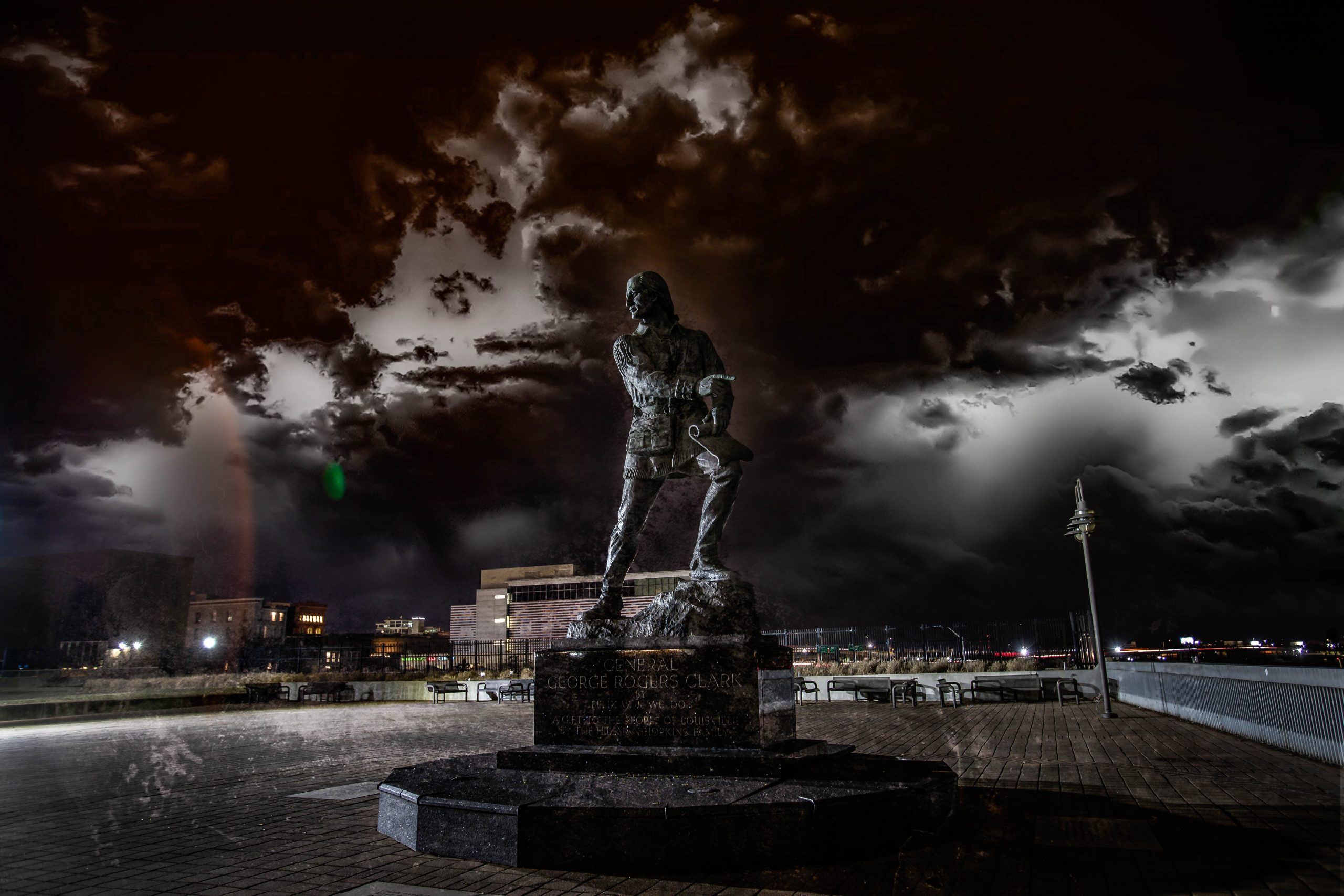
Looking out over the Ohio River, a statue of US General George Rogers Clark has stood proudly in the heart of downtown Louisville for over 50 years. Widely known for being the founder of Louisville, Clark was the highest-ranking American military officer in the entire northwestern United States.
But his military achievements have been justifiably overshadowed by his legacy of murder, cruelty, and oppression, all of which have gone on to tarnish his image. As Clark’s reputation becomes increasingly controversial, strange, chilling incidents, have started to take place around his statue, creating inexplicably dark energy for those who dare to visit. Join Derby City Ghosts to learn more about the troubled legacy of Louisville’s once-trusted founder and see why some visitors refuse to get close to his statue.
QUICK FACTS:
George Rogers Clark is remembered for being a decorated soldier and the founder of Louisville, though the land had been used as hunting grounds by Shawnee and Cherokee tribes for years prior. The first settlement in the vicinity of modern-day Louisville was established in the latter part of the Revolutionary War as part of a campaign to bring settlers to Kentucky.
But truthfully, Clark believed the area would be ideal for a communications post in the country’s efforts against the British—not just as a new settlement. Eighty citizens and 150 soldiers set out from Redstone, Pennsylvania, in 1778 and helped Clark hide the real reason behind his presence in the area. A local government was established shortly after.
Widely considered to be an American war hero, Clark gained recognition as a prominent military leader after successfully capturing British forts at Kaskaskia and Vincennes, eventually leading to the Treaty of Paris in 1783, which granted the US its independence. Today, Clark seemingly is treated like a deity around the city of Louisville. There are schools, parks, and even a bridge named after him, and he remains a legendary figure amongst residents.
But despite his wartime triumphs, Clark’s legacy is complex, considering he was responsible for ordering attacks on Native American settlements. To fight against the British during the Revolutionary War also meant fighting against Native Americans in especially horrific, cruel ways. The Redcoats promised Native Americans protection and money in return for their help fighting rebels, but when the time came for the British to aid their supposed “allies,” no one showed up to help.
To force a surrender, Clark slaughtered five Native Americans with a hatchet in present-day Vincennes, Indiana. Clark’s men also scorched the Shawnee village of Peckuwe, burning their crops, looting their burial grounds, and killing innocents, leaving the Shawnee starving. Today, this knowledge has irreversibly plagued Clark’s legacy, with many questioning his senseless actions, violence, and cruelty against Native American tribes.
In 1970, a statue depicting George Rogers Clark was placed along the Belvedere Waterfront Park in downtown Louisville. Sculpted by Felix W. de Weldon, the monument shows Clark pointing westward, an embodiment of his heroic yet later controversial actions during the Revolutionary War.
The monument has long been said to have a dark energy, perhaps a magnet for otherworldly forces and spirits from beyond the grave…those seeking revenge for the day their lives were so viciously taken by Clark and his men.
Although many strange happenings have taken place around Clark’s statue, one particular spirit has frequently been seen by visitors over the years: the ghost of George Rogers Clark himself. His bloody history seems to have caught up with him, and now, Clark haunts the very statue dedicated to him and his time on Earth.
It’s unknown if he appears as a full-body apparition or just a ghostly presence, but he’s been responsible for giving countless visitors a fright. Towards the end of his life, his reputation took a hit after he started drinking heavily and dodging creditors. And with the more recent controversies surrounding his attacks on Native Americans, Clark’s spirit is starting to get defensive.
Some visitors to the statue have reported feeling a cold, angry energy in the air, while others claim to have felt someone touching, pushing, or pinching them when they stepped too close to the statue. According to some, Clark’s eyes have even started glowing.
The statue of George Rogers Clark has popped up in the news on several occasions in recent years, especially in the wake of the 2020 BLM protests. At the time, young people were and are continuing to call for the removal of monuments and statues that depict harmful historical figures, and Clark’s statue is no exception.
Clark’s legacy will always be complex, especially to the people of Louisville, who will always know Clark as their beloved city’s not-so-beloved founder. Check out our blog to discover more of the most haunted statues and memorials across the US, and be sure to keep up with US Ghost Adventures on Facebook, Instagram, and TikTok.
Sources Cited:
https://en.wikipedia.org/wiki/Louisville,_Kentucky,_in_the_American_Civil_War
https://www.lpm.org/news/2020-10-05/george-rogers-clark-statue-vandalized-in-downtown-louisville
https://louisvilleky.gov/arts-culture/document/louis-xvi-timeline